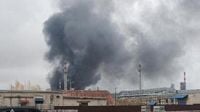In a bold escalation of its long-range campaign, Ukraine has struck more than 160 Russian oil refineries and energy facilities since the start of 2025, marking a significant turn in the ongoing conflict between the two countries. According to Vasyl Maliuk, head of the Security Service of Ukraine (SBU), these precision strikes—many using domestically produced drones and Neptune cruise missiles—have inflicted deep wounds on Russia’s energy sector, causing fuel shortages, refinery shutdowns, and widespread disruptions to Moscow’s war economy.
At a press conference on October 31, Maliuk detailed the extent of Ukraine’s offensive. "We are implementing what we call kinetic sanctions—deep strikes into the enemy’s rear using drones at ranges beyond 120 kilometers," he explained, as reported by Censor.NET and corroborated by BBC and RBC-Ukraine. These operations, Maliuk emphasized, are carefully targeted at lawful military and economic objectives, specifically oil production and refining facilities that directly support Russia’s military efforts.
In just September and October, Ukrainian forces hit 20 critical facilities, including six refineries, two oil terminals, three fuel depots, and nine pumping stations. The impact has been dramatic: Maliuk stated, “This has caused a 20% shortfall on the domestic market for petroleum products and a 37% idle rate of refining capacity.” These figures are echoed by international observers. The International Energy Agency estimates that the strikes have slashed Russia’s refining output by 500,000 barrels per day, with the damage expected to keep processing rates low until at least mid-2026.
The economic fallout is already visible. Bloomberg data cited by BBC shows that Russia’s fuel exports have plunged to wartime lows, with seaborne oil product shipments dropping to 1.89 million barrels per day in October—the lowest since the full-scale invasion began. The fuel deficits have rippled across 57 Russian regions, forcing the Kremlin to impose a ban on gasoline exports through the end of 2025, as reported by United24 Media.
Ukraine’s campaign has evolved from opportunistic attacks to a systematic strategy of economic warfare. According to BBC Verify, 21 of Russia’s 38 major refineries have been struck since January, with attacks peaking in August and remaining high through October. Each successful strike not only disrupts operations but also creates a repair crisis. Western sanctions have made it nearly impossible for Russian refineries to obtain specialized equipment, so each breakdown—whether from combat or routine failure—can leave facilities offline for extended periods.
One of the most notable recent incidents involved Rosneft’s Novokuybyshevsk oil refinery, which halted primary crude processing after being hit by drones twice in October. The AVT-11 crude distillation unit, capable of processing about 138,540 barrels per day, was shut down, and another unit had already been offline, according to Reuters sources. The cumulative effect of such strikes is a staggering reduction in Russia’s oil production—up to 90%, according to Maliuk. "Oil production and refining make up 90% of Russia’s defense budget. These are dirty oil rubles, paid for with which the enemy kills us," he asserted.
Ukrainian ingenuity has played a major role in these operations. On the night of October 31, Ukrainian Navy forces used domestically produced Neptune cruise missiles to strike the Oryol Thermal Power Plant (TPP) and the Novobryansk electrical substation in Russia’s Oryol Oblast. The Ukrainian Navy reported that these facilities supplied power to military-industrial plants, and their destruction "dealt a serious blow to the occupiers’ logistics." Surveillance footage captured the large blast at the Oryol plant, and local residents reported blackouts across the city, as detailed by The Kyiv Independent.
Russian officials offered a different account. Oryol Oblast Governor Andrey Klychkov claimed the Oryol TPP was damaged by debris from intercepted drones, but he insisted there were no fires or casualties and that power had been “almost completely restored.” Nevertheless, footage analyzed by Russian opposition channel Astra showed two strikes on the plant, and local residents said the attack did not sound like drones. Explosions were also reported in Vladimir and Yaroslavl, with air defenses operating in both areas. In Vladimir, a major electrical substation was hit, and in Yaroslavl, blasts occurred near the Novo-Yaroslavsky oil refinery—the fifth-largest in Russia.
Ukraine’s campaign hasn’t been limited to oil infrastructure. Maliuk revealed that since the start of 2025, Ukrainian forces have destroyed 48% of Russia’s Pantsir air defense systems, a significant dent given that Russia produces only about 30 of these systems per year. In Crimea, SBU strike drones recently destroyed a Pantsir-S2 system valued at about $20 million, along with two radar stations, further eroding Russia’s defensive capabilities.
The strikes on Russian infrastructure have come in the context of ongoing tit-for-tat attacks. Just a day before the Neptune missile strikes, Russian forces launched a mass missile and drone attack against Ukraine’s energy infrastructure, targeting multiple thermal power plants and killing two people at the Sloviansk Thermal Power Plant in Donetsk Oblast. Ukrainian President Volodymyr Zelensky condemned Russia’s assault as “exclusively terror.”
Ukraine’s approach—combining kinetic strikes with Western sanctions—has placed unprecedented pressure on Russia’s energy sector. The deliberate targeting of oil and energy infrastructure is designed to choke off the Kremlin’s primary source of military funding and erode its ability to sustain the war. As Maliuk put it, "In addition to sanctions, we also have kinetic sanctions. That is, deep strikes work in the deep rear, using drones. We are talking about a distance of 120 kilometers plus." He stressed that these attacks are carried out in strict accordance with the tasks set by President Zelensky, focusing only on legitimate military and economic targets.
The knock-on effects of Ukraine’s campaign are already being felt not only on the battlefield but also in Russian society, with fuel shortages, refinery shutdowns, and a growing sense of vulnerability in regions once considered safely behind the front lines. As the war grinds on, Ukraine’s ability to innovate and strike deep into Russian territory may well prove decisive—not just militarily, but economically and psychologically.
In the high-stakes contest for control of energy and resources, Ukraine’s relentless assault on Russia’s oil empire is reshaping the conflict’s dynamics in real time, leaving Moscow scrambling to adapt to a new and deeply unsettling reality.






